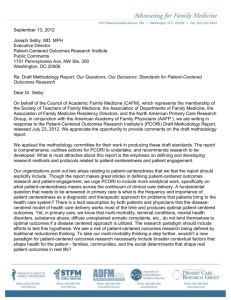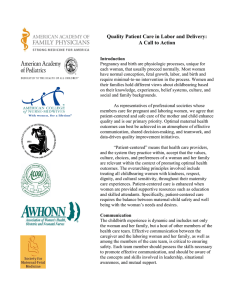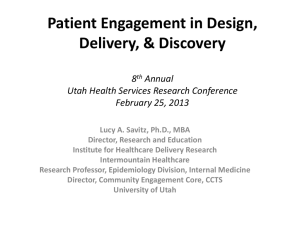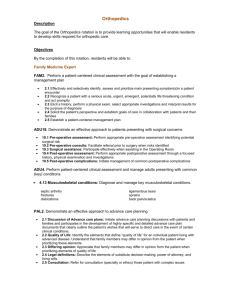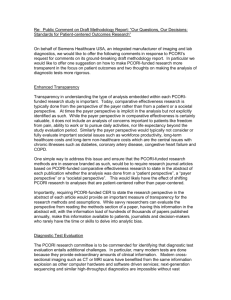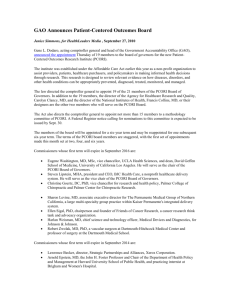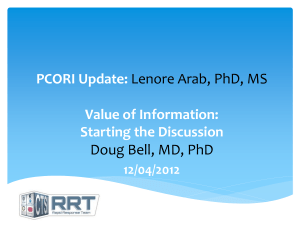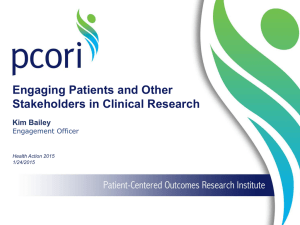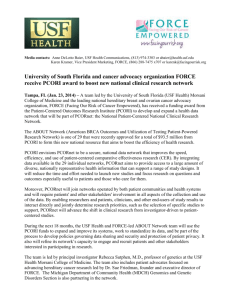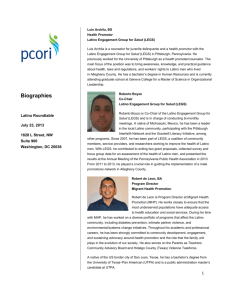Comments on PCORI National Priorities
advertisement
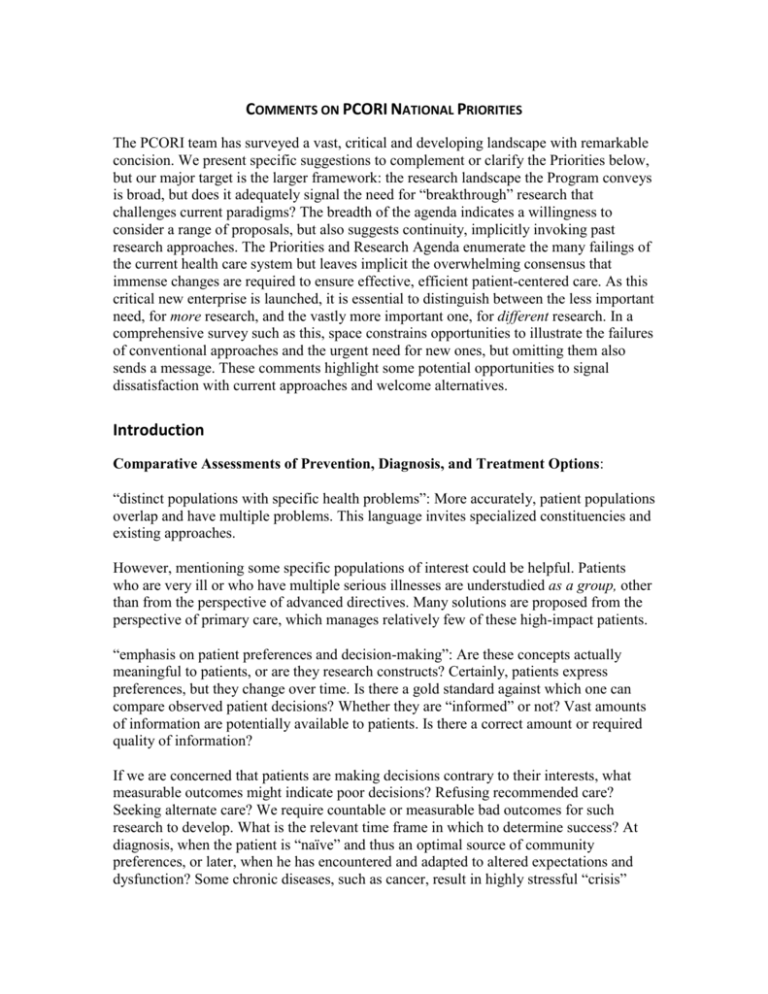
COMMENTS ON PCORI NATIONAL PRIORITIES The PCORI team has surveyed a vast, critical and developing landscape with remarkable concision. We present specific suggestions to complement or clarify the Priorities below, but our major target is the larger framework: the research landscape the Program conveys is broad, but does it adequately signal the need for “breakthrough” research that challenges current paradigms? The breadth of the agenda indicates a willingness to consider a range of proposals, but also suggests continuity, implicitly invoking past research approaches. The Priorities and Research Agenda enumerate the many failings of the current health care system but leaves implicit the overwhelming consensus that immense changes are required to ensure effective, efficient patient-centered care. As this critical new enterprise is launched, it is essential to distinguish between the less important need, for more research, and the vastly more important one, for different research. In a comprehensive survey such as this, space constrains opportunities to illustrate the failures of conventional approaches and the urgent need for new ones, but omitting them also sends a message. These comments highlight some potential opportunities to signal dissatisfaction with current approaches and welcome alternatives. Introduction Comparative Assessments of Prevention, Diagnosis, and Treatment Options: “distinct populations with specific health problems”: More accurately, patient populations overlap and have multiple problems. This language invites specialized constituencies and existing approaches. However, mentioning some specific populations of interest could be helpful. Patients who are very ill or who have multiple serious illnesses are understudied as a group, other than from the perspective of advanced directives. Many solutions are proposed from the perspective of primary care, which manages relatively few of these high-impact patients. “emphasis on patient preferences and decision-making”: Are these concepts actually meaningful to patients, or are they research constructs? Certainly, patients express preferences, but they change over time. Is there a gold standard against which one can compare observed patient decisions? Whether they are “informed” or not? Vast amounts of information are potentially available to patients. Is there a correct amount or required quality of information? If we are concerned that patients are making decisions contrary to their interests, what measurable outcomes might indicate poor decisions? Refusing recommended care? Seeking alternate care? We require countable or measurable bad outcomes for such research to develop. What is the relevant time frame in which to determine success? At diagnosis, when the patient is “naïve” and thus an optimal source of community preferences, or later, when he has encountered and adapted to altered expectations and dysfunction? Some chronic diseases, such as cancer, result in highly stressful “crisis” decisions, with anticipation of downstream decisions deferred not because they are unlikely but because they are uncomfortable. Finally, does the term “informed” imply only rational input? Seriously ill patients are frightened, and their decisions are heavily influenced by emotion. These factors drive overuse of medical care in seriously ill patients. Improving Healthcare Systems: “self-care”: This is the sole reference to the participation of patients in their care once decisions have been made. (Other roles appear to be confined to the research agenda, such as whether outcomes are meaningful to them and their contribution to research design.) Why focus on so-called “physician extenders” rather than on patients’ roles in their day-to-day care? Patients are certainly motivated and well placed to play a decisive role in all medical activity that involves them. Their potential for preventing medical errors is obvious, if underutilized, but larger roles are easy to identify. For example, uncoordinated and discontinuous care is costly and dangerous. The patient may have the greatest motivation of all stakeholders to avoid redundant diagnostic workups or discontinuities in medication prescriptions that result from changes in treatment venue or provider. Communication and Dissemination: Is the assumption that decisions are supported through providing “good quality” information? Are there non-rational factors that distort outcomes? (See above) Connotations of language are becoming more important (e.g., the proposal to remove “cancer” from the terminology for low risk prostate neoplasms). “ways to use electronic data (“e-health records”) to support decision-making”: There has been little attention to how the EMR can disrupt decision-making, by producing inaccurate information, useless warnings that produce “alarm fatigue” or create artificial patient preferences at variance from decisions made in the absence of such exercises. Virtually no clinicians rely on, for example, pain scores that are documented relentlessly, and most progress notes contain inaccuracies produced by prepopulated fields or reliance on editing copies of previous notes. Addressing Disparities: Ambiguity about the meaning of “disparities” confuses and undermines this objective. The usual meaning is substandard care for patients who are “disadvantaged,” primarily because of demographic differences from the culturally dominant group making medical decisions. In this document, the meaning of “disparities” appears at times to mean “effect modification,” which is almost certainly less important than bias in producing disparities in patient outcomes. Accelerating Patient-Centered and Methodological Research: What is the conceptual link between patient-centered and methodological research? What makes research “patient-centered”? External CER Priorities appear to avoid direct inclusion of quality improvement, but rather error prevention (safety) and avoiding overuse. At a minimum it ignores 1/3 of Wennberg’s taxonomy: effective care, patient-sensitive care and demand-sensitive care. One could argue that PCORI’s overarching goal is determining which care is effective, but without development that is just a slogan, not a program with specific content. Proposed Research Agenda The comments above are relevant to the more detailed presentations and language of this section. General Comments: Quality improvement per se is not addressed, although medical errors and practice variations, which characterize poor care, are mentioned. Practice variation is introduced in a constricted sense: “Does this area currently show wide variations in clinical practice?” This leads to a narrow focused on 2 potential causes: lack of clear evidence for a preferred choice or lack of awareness of evidence. Wennberg’s distinctions between effective care, preference-drive care and demand driven care, which inform the concept of practice variation, do not address additional procedures for identifying inferior techniques or incorporating new information and technology (the latter was an IOM Priority). The conventional pivotal trials framework addresses research “strategies” but not the “tactics” of carrying them out; Wennberg’s analytic approach produced the empirical argument that 1/3 of health care expenditures do not contribute to health, and the Dartmouth Atlas documents variations in medical resource use, but the approach does not identify useless care or suboptimal approaches. Provider morale and medical education are both highly relevant to transformational change and are not mentioned. The choice to avoid of a “restricted set of conditions or treatments” misses an opportunity to critique the unjustified dominance of the primary care paradigm. There is little evidence that primary care provides an optimal fulcrum for coordinating complicated, specialized care, and the experience with primary care “gatekeeping” in the 80’s and 90’s is a strong counter-example. Therefore, it is unclear why primary care and the diseases it primarily manages should be considered privileged perspectives. There are other paradigms than that of diabetes/hypertension chronic care. Cancer features a crisis management paradigm, with decisions made with a near-exclusive focus on the shortterm, a very different decision-making process highly relevant to the patient-cantered, patient-focused emphasis of PCORI. Comparative Assessments of Prevention, Diagnosis, and Treatment Options: Patient-centered/decision-making: research should address patient adaptation and learning in decision-analytic modeling. The theoretical basis of decision analysis requires using the naive patient as the decision-maker and source of preferences and, to calculate long-term outcomes, assuming no adaptation (at least in terms of preference ascertainment). Yet patients do clearly adapt, becoming less naive and more “in control” as they learn about their disease and adopt an updated perspective over time, just as aging requires ongoing “new normal” perspectives. Failure to include the information that patients adapt must result in less well-informed decisions. The longitudinal perspective may be the most useful paradigm for studying patient decision-making in novel, useful ways, rather than continuing to refine existing methodology focused on short-term patient satisfaction. This static concept of the patients limits research. Improving Healthcare Systems: If we require “breakthrough” changes, this language may invoke too incremental changes. This should be an area where the challenge to conventional wisdom and attachments to current paradigms and techniques is the strongest. 1) Proposals to improve the use of IT, not just expand it. “Meaningful use” criteria have no proven relationship with improved patient outcomes; 2) There is an unacknowledged conflict between “overuse” of medical technology and the global assumption that “more” IT is beneficial to medicine; 3) We should exploration of “bad” uses of technology (e.g., potential for creating and perpetuating erroneous information, too much information – complicating finding useful information – and distraction). Communication and Dissemination Research: This should be explicitly linked to QA/QI programs? How does CME fit into this objective? My guess is that it has little role in PCORI thinking, but it should be clear; huge resources are invested in this model. There is a conflict between modeled decisionmaking, which usually assumes a parametric, multiple regression model and the way patients think, which is largely binary. Research should emphasize decision thresholds for using a variety of data, especially patient-reported, which is being incorporated into the Labs section of patient medical records but has modest value as currently used. Standards for public presentation of outcomes data would be useful?
